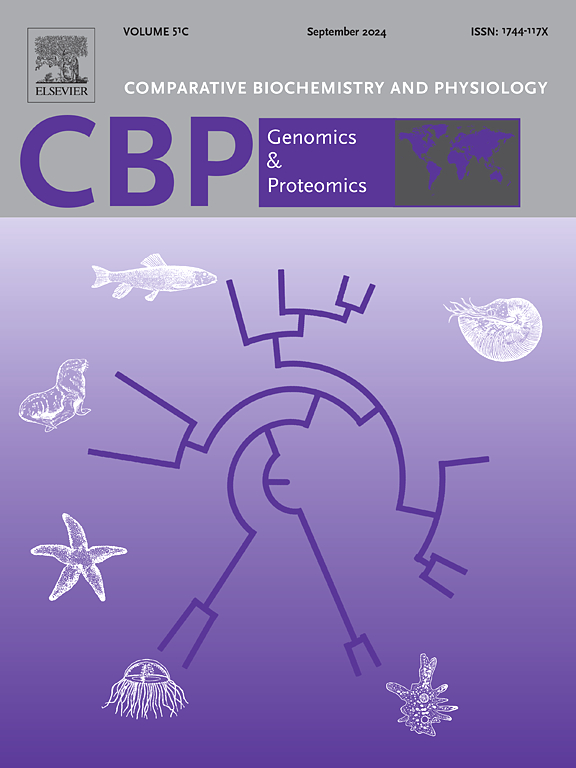Comparative biochemical, transcriptome and metabolome investigation on reproductive maturation of wild and captive female Monopterus albus
IF 2.2
2区 生物学
Q4 BIOCHEMISTRY & MOLECULAR BIOLOGY
Comparative Biochemistry and Physiology D-Genomics & Proteomics
Pub Date : 2025-06-14
DOI:10.1016/j.cbd.2025.101567
引用次数: 0
Abstract
The main purpose of this study is to systematically elucidate mechanisms underlying ovarian development in wild and captive female Monopterus albus at the biochemical, transcriptomic, and metabolomic levels. Wild and captive female M. albus in Shanghai were continually collected over 1 year, and their ovarian development was analyzed statistically. We determined serum lipid metabolism and hormone contents of the fish during the study period, along with the largest differences in gonadosomatic indices (GSIs), and performed then transcriptome and metabolome detection analysis on their ovaries. The results demonstrated that wild group had approximately 1 month longer reproductive period than the captive group. Moreover, during the reproductive period, the wild group had higher GSIs than the captive group. Compared with the captive group, the wild group demonstrated significantly higher serum triglyceride, total cholesterol, high-density lipoprotein cholesterol, low-density lipoprotein cholesterol, 17β-estradiol, and progesterone contents in serum. Transcriptome and metabolome analyses revealed that 2318 genes and 172 metabolites were upregulated in the wild group, whereas 662 genes and 223 metabolites were downregulated. Furthermore, integrated transcriptome and metabolome analyses revealed that cholesterol metabolism was significantly affected, indicating that it was the main pathway affecting ovarian development in both wild and captive female M. albus. In this pathway, 17 genes (including apolipoprotein A, lipoprotein lipase and sortilin) and 2 metabolites (taurocholic acid and taurochenodesoxycholic acid) were significantly upregulated. In general, ovarian development was better in wild female M. albus than farmed ones.

野生和圈养雌黄鳝生殖成熟的比较生化、转录组和代谢组研究
本研究的主要目的是在生化、转录组学和代谢组学水平上系统地阐明野生和圈养黄鳝雌性卵巢发育的机制。连续采集上海地区野生和圈养雌白纹姬鼠1年,对其卵巢发育情况进行统计分析。我们测定了研究期间鱼的血清脂质代谢和激素含量,以及促性腺指数(GSIs)的最大差异,并对其卵巢进行了转录组和代谢组检测分析。结果表明,野生组的繁殖周期比圈养组长约1个月。在繁殖期内,野生组的gsi高于圈养组。与圈养组相比,野生组血清中甘油三酯、总胆固醇、高密度脂蛋白胆固醇、低密度脂蛋白胆固醇、17β-雌二醇和黄体酮含量显著升高。转录组和代谢组分析显示,野生组中有2318个基因和172个代谢物上调,而662个基因和223个代谢物下调。此外,综合转录组学和代谢组学分析显示,胆固醇代谢受到显著影响,表明它是影响野生和圈养雌性白颡鱼卵巢发育的主要途径。在这条通路中,17个基因(载脂蛋白A、脂蛋白脂肪酶和sortilin)和2个代谢产物(牛磺胆酸和牛磺酸去氧胆酸)显著上调。总体而言,野生雌白念珠菌卵巢发育较养殖雌念珠菌好。
本文章由计算机程序翻译,如有差异,请以英文原文为准。
求助全文
约1分钟内获得全文
求助全文
来源期刊
CiteScore
5.10
自引率
3.30%
发文量
69
审稿时长
33 days
期刊介绍:
Comparative Biochemistry & Physiology (CBP) publishes papers in comparative, environmental and evolutionary physiology.
Part D: Genomics and Proteomics (CBPD), focuses on “omics” approaches to physiology, including comparative and functional genomics, metagenomics, transcriptomics, proteomics, metabolomics, and lipidomics. Most studies employ “omics” and/or system biology to test specific hypotheses about molecular and biochemical mechanisms underlying physiological responses to the environment. We encourage papers that address fundamental questions in comparative physiology and biochemistry rather than studies with a focus that is purely technical, methodological or descriptive in nature.

 求助内容:
求助内容: 应助结果提醒方式:
应助结果提醒方式:


